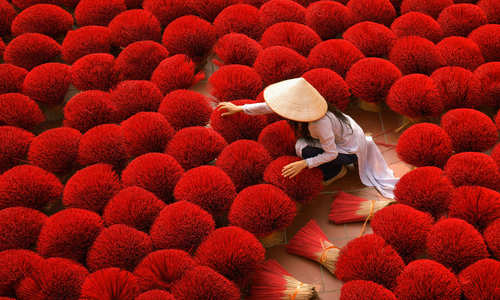Article content
20 January 2015
Alex Robinson heads south to discover secret spots and hidden pleasures.
Pictures by the author
Folds of emerald green mountains stretched before me to a misty-blue horizon. A line of trees stood silhouetted against the sky, high on a distant ridge. Below them was a wisp of falling water, which dropped into a pool, spilled over and fell again into the forest. In the eerie stillness of the tropical air, I could just make out the far-off sound of its cascade.
"A Chinese painting in motion," I thought, drifting into a Taoist reverie. "Ripples, following ripples, trickling don the hills, from far off fountains to where their waters flow into the sea..."
"Tigerly!!"

A cry shattered the silence and sent my head spinning round, scowling - at Bau who was shouting at me from further down the path. And gesticulating.
What did he want? How could he destroy this Zen-like moment? Did the man have no poetic feeling?
"Tigerly?" the guide shouted again, and rushed towards me, deftly skipping over the buttress root of a huge rainforest tree. He was pointing at my lower neck.
I ran my hand over the spot. It was wet, sticky, and yeuch... bright red.
My God I was bleeding! What was wrong with me? Ebola? No, I'm in Thailand. Haemorrhagic fever, then? Vampire bats? Zen-like calm turned to panic. I felt faint. I was miles from anywhere. I could die out here in this godforsaken wilderness!
"Tiger-ly!!" said Bau more softly, smiling. By now he was right next to me. He brushed his hand over my dripping neck and plucked off what looked like a fat, brown worm.
Tiger-lee. Tiger leech. And it was gorged with blood.
Bau plugged the miniscule wound with a piece of cotton wool from the first-aid tin as my blanched face quickly turned red.
He handed me water, slapped me on the back to ease my discombobulation. I recovered my composure, grinned apologetically and we set off again up the path - past that glorious view and into the heart of Khao Luang National Park.

My journey to southern Thailand had begun with a bet in a London pub. I was lamenting the lack of unspoilt country in Thailand's once beautiful south.
"It's all tourists, tacky hotels and spa resorts," I proclaimed pompously. "I won't go there anymore. I like to travel away from the crowds."
As I rambled on about Samui and Koh Phi Phi's glory days, my Thai friend giggled. I was wrong, she said. Southern Thailand was empty.
"Take the train from Bangkok to Trang," she said, "Get off anywhere you like."
So I did. And I hadn't seen a tourist since.
I began in the royal retreat of Phetchaburi, set in hills pocked with effigy-filled caves and steepled with Khmer-style temples decorated with fang-toothed demons in stucco and serene, gilt buddhas. A grand palace built by Rama IV sat sentinel on a rocky hill in the centre of the city. It was here that the English schoolteacher Anna Leonowens taught the royal progeny English. I imagined her looking out over the rainforest-covered hills that surround Phetchaburi and thinking of her own daughter Avis - far from Siam in an English boarding school - estranged from her mother by the very job that paid for her education.
From Phetchaburi I caught the train south to the capital of southern Thailand - Nakhon Si Thammarat - founded as the ancient capital of the 7th-century Tambralinga kingdom, which dominated much of the Malay peninsula and traded with India and Tang-dynasty China. The city was steeped in history and littered with magnificent monuments. I watched classical Thai dance performed under the crumbling old city walls and a canopy of shimmering stars, and wandered round the giant chedi at Wat Mahathat - one of Thailand's holiest and most opulent Buddhist temples. And I joined a brightly-coloured parade of dancers, drum orchestras, blackened demons and beauty queens on flower-covered floats, as they celebrated the festival of the Tenth Lunar month under a baking November sun.
It was in Nakhon Si Thammarat that a group of university students told me about Khao Luang. It was one of the most beautiful stretches of rainforest in Asia they said - so wild and untamed that tiger and forest elephant still roamed its steep valleys and high ridges.
Bau and I reached the crest of our ridge and made camp by a rushing stream in a forest glade coloured with dozens of creamy orchids. I slept uneasily, dreaming of tigers. And tiger leeches. I woke repeatedly - at a rustle in the undergrowth or a strange whirr or chirrup in the pitch black of the forest night.
By the time we returned to Nakhon late the following morning, I was ready for some soothing sun and sand. So I climbed back on the train for the Andaman coast in Trang and a boat to one of Thailand's least-known archipelagos. I saw just a handful of intrepid German backpackers on my crossing from the mainland to cliff-cragged Koh Muk island. And they were sitting on crates of UHT milk destined for the island school.
My beach villa at the Koh Muk Sivalai sat right over the sand - with a magnificent view of limestone peaks and turquoise sea. I looked north to an empty horizon. An hour's boat ride would bring me to the beach bars of Ao Nang in Krabi - where tourists cram the sand and aquamarine bays buzz with long-tail boats. Here all was peace and stillness. And I thought again of those lines from Edwin Arnold: "Ripples, following ripples, fast or slow - / The same yet not the same - from far-off fountain / To where its waters flow / Into the seas..."






